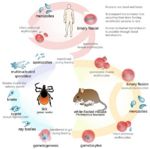Difference between revisions of "Babesia"
Jump to navigation
Jump to search
Fiorecastro (talk | contribs) |
|||
| (16 intermediate revisions by 5 users not shown) | |||
| Line 1: | Line 1: | ||
| − | + | [[Image:Babesia Life Cycle.jpg|thumb|right|150px|''Babesia'' Life Cycle Diagram - Dennis Jacobs & Mark Fox RVC]] | |
| + | [[Image:Alternative Babesia life cycle diagram.jpg|thumb|right|150px|''Babesia'' Life Cycle - Mariana Ruiz Villarreal]] | ||
*Infects a wide range of host species in different areas of the world | *Infects a wide range of host species in different areas of the world | ||
| − | Babesiosis has severe effects on cattle production in parts of the world | + | *Babesiosis has severe effects on cattle production in parts of the world |
| + | **Prevents European breeds from being successful in tropical regions where [[Ticks|ticks]] are endemic. | ||
| + | **Occurs sporadically in the UK and Ireland causing losses of around £8 million per year | ||
| − | + | '''Life Cycle''' | |
| − | Both [[Ticks#Disease Transmission|trans-stadial]] and [[Ticks#Disease Transmission|trans-ovarian]] transmission occurs | + | *Both [[Ticks#Disease Transmission|trans-stadial]] and [[Ticks#Disease Transmission|trans-ovarian]] transmission occurs |
| − | ''Babesia'' multiplies in the red blood cells by '''budding''' | + | *Each female [[Ticks|tick]] produces 3000 eggs |
| − | Giemsa blood smears can differentiate between species using 'Difquik' stain | + | |
| + | *The [[Ticks|tick]] is the definitive host | ||
| + | |||
| + | *''Babesia'' multiplies in the red blood cells by '''budding''' | ||
| + | **Forms 2-4 daughter cells (species dependent) | ||
| + | **Giemsa blood smears can differentiate between species using 'Difquik' stain | ||
*''Babesia'' species are either small or large depending on the size of the daughter cells | *''Babesia'' species are either small or large depending on the size of the daughter cells | ||
| Line 28: | Line 36: | ||
*Antigen is released which adsorbs onto other red blood cells | *Antigen is released which adsorbs onto other red blood cells | ||
| − | **Causes haemolysis and [[Pigmentation - Pathology#Haemoglobin|haemoglobin pigmentation]] | + | **Causes haemolysis and [[Pigmentation and Calcification - Pathology#Haemoglobin|haemoglobin pigmentation]] |
**Causes haemolytic anaemia, haemoglobinuria and fever | **Causes haemolytic anaemia, haemoglobinuria and fever | ||
| Line 54: | Line 62: | ||
*'''Lower''' incidence of disease | *'''Lower''' incidence of disease | ||
| − | |||
<big>'''[[Babesiosis - Cattle|Cattle Babesiosis]] | <big>'''[[Babesiosis - Cattle|Cattle Babesiosis]] | ||
| − | '''[[ | + | '''[[Babesiosis - Dogs|Dog Babesiosis]] |
| − | '''[[Babesiosis - Horse|Horse Babesiosis]] | + | '''[[Babesiosis - Horse|Horse Babesiosis]] |
'''[[Babesiosis - Small Ruminants|Sheep and Goat Babesiosis]] | '''[[Babesiosis - Small Ruminants|Sheep and Goat Babesiosis]] | ||
</big> | </big> | ||
| − | |||
| − | |||
| − | |||
| − | |||
| − | |||
| − | |||
| − | |||
[[Category:Piroplasmida]] | [[Category:Piroplasmida]] | ||
[[Category:To_Do_-_Parasites]] | [[Category:To_Do_-_Parasites]] | ||
Revision as of 22:17, 26 June 2010
- Infects a wide range of host species in different areas of the world
- Babesiosis has severe effects on cattle production in parts of the world
- Prevents European breeds from being successful in tropical regions where ticks are endemic.
- Occurs sporadically in the UK and Ireland causing losses of around £8 million per year
Life Cycle
- Both trans-stadial and trans-ovarian transmission occurs
- Each female tick produces 3000 eggs
- The tick is the definitive host
- Babesia multiplies in the red blood cells by budding
- Forms 2-4 daughter cells (species dependent)
- Giemsa blood smears can differentiate between species using 'Difquik' stain
- Babesia species are either small or large depending on the size of the daughter cells
- Small Babesia
- E.g. B. divergens
- E.g. B. gibsoni
- Peripheral nucleus
- Obtuse angle
- Large Babesia
- E.g. B. major
- E.g. B. canis-complex
- Central nucleus
- Acute angle
- Daughter cells disrupt the red blood cell and are released
- Spread and infect other red blood cells
- Antigen is released which adsorbs onto other red blood cells
- Causes haemolysis and haemoglobin pigmentation
- Causes haemolytic anaemia, haemoglobinuria and fever
Enzootic Instability
- Low rate of transmission
- Few infected ticks
- Infrequent exposure
- Immunity wanes or is completely absent in many individuals
- Low levels of herd immunity
- Higher incidence of disease
Enzootic Stability
- High rate of transmission
- Many infected ticks
- Frequent exposure boosts immunity
- High level of herd immunity
- Lower incidence of disease

